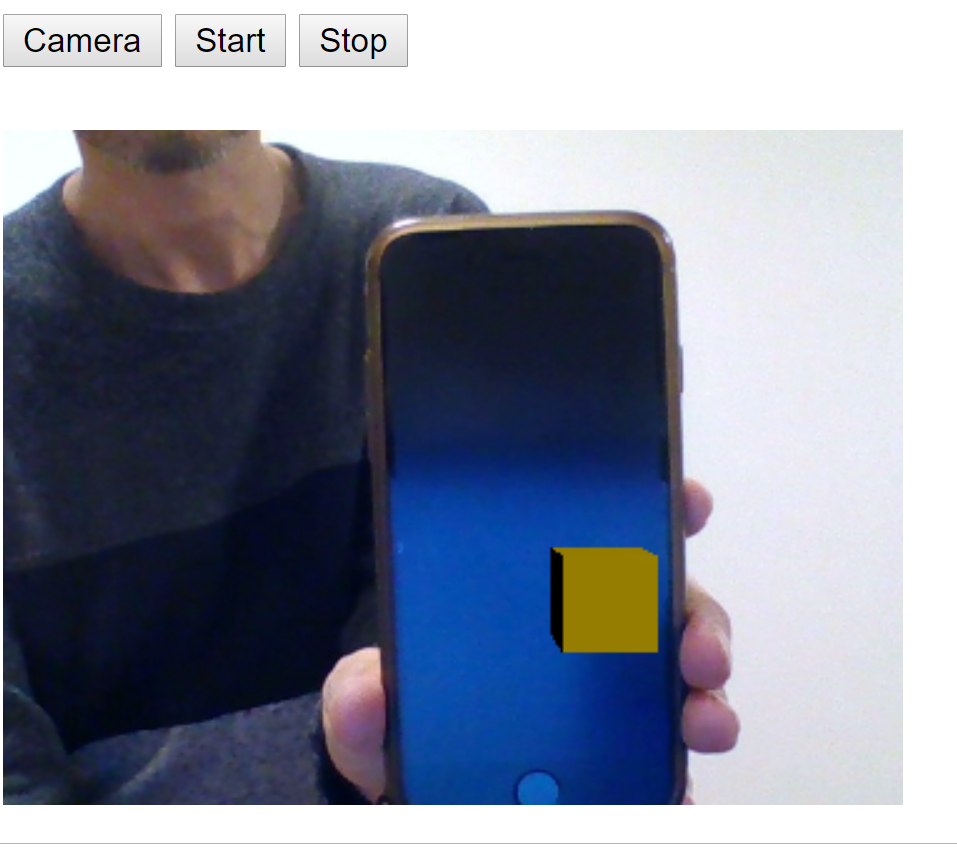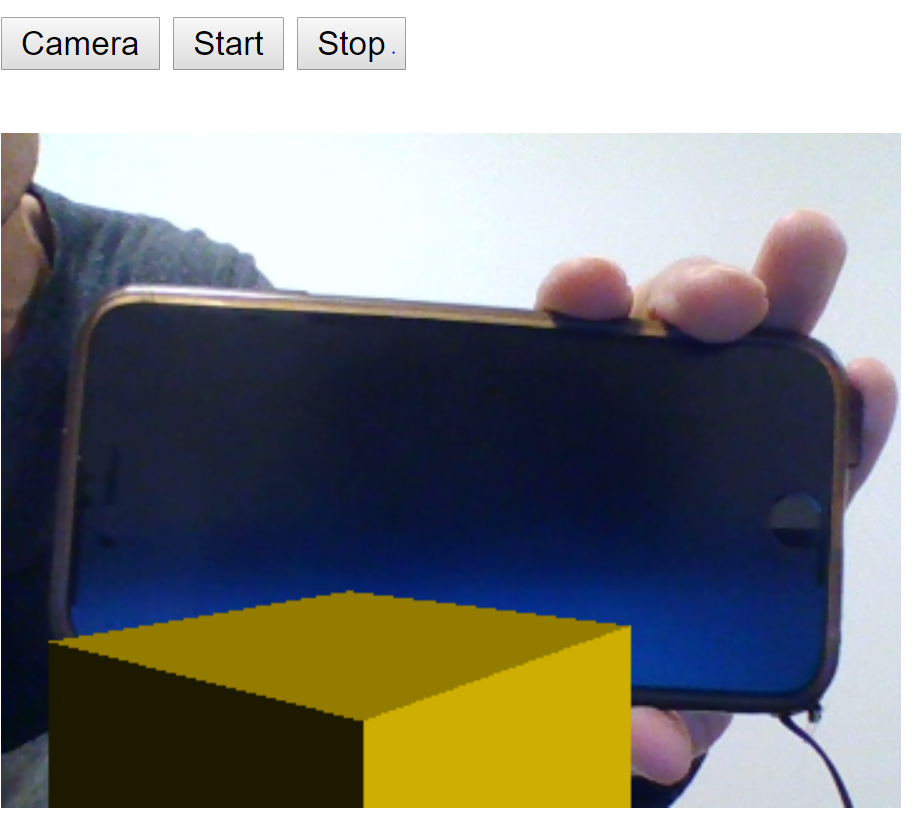目的
- Tensorflow.js の object detection model を試す。
- Three.js を使ってみる。
参照
Three.js のサンプル
index.js
let fs = require('fs')
let express = require('express');
let app = express()
app.use(express.static('public'));
app.get('/', (request, response) => {
fs.readFile('./index.html', 'UTF-8',
(error, data) => {
response.send(data);
})
})
app.listen(3000, () => {
console.log('Start server.')
})
index.html
<!DOCTYPE html>
<html>
<head>
<meta charset="utf-8"/>
<script src="https://cdnjs.cloudflare.com/ajax/libs/three.js/101/three.min.js"></script>
</head>
<body>
<h2>AR</h2>
<button id="camera-button">Camera</button>
<button id="start-button">Start</button>
<button id="stop-button">Stop</button><br><br>
<video id="video" width="360" height="270"></video><br><br>
<img id="img" src="./img/test1.jpg" width="360", height="270"><br><br>
<canvas id="canvas" width="360" height="270"></canvas><br>
<script>
const cameraButton = document.getElementById('camera-button');
cameraButton.onclick = () => {
startWebcam();
}
const startButton = document.getElementById('start-button')
startButton.onclick = () => {
start();
}
const stopButton = document.getElementById('stop-button')
stopButton.onclick = () => {
console.log('test');
location.reload();
}
const video = document.getElementById('video');
function startWebcam() {
console.log("video streaming start.");
navigator.mediaDevices.getUserMedia({
audio: false,
video: true
})
.then((stream) => {
video.srcObject = stream;
video.play();
})
.catch(err => alert(err));
}
const img = document.getElementById('img');
const canvas = document.getElementById('canvas');
function start() {
const scene = new THREE.Scene();
const width = 360;
const height = 270;
const fov = 45;
const aspect = width / height;
const near = 0.1;
const far = 1000;
const camera = new THREE.PerspectiveCamera(fov, aspect, near, far);
camera.position.set(0, 0, 200);
const renderer = new THREE.WebGLRenderer();
renderer.setSize(width, height);
document.body.appendChild(renderer.domElement);
const directionalLight = new THREE.DirectionalLight('white');
directionalLight.position.set(1, 1, 1);
scene.add(directionalLight);
var geometry = new THREE.PlaneGeometry(width, height);
//const texture = new THREE.TextureLoader().load( './img/test1.jpg' );
//const texture = new THREE.TextureLoader().load( img.src );
//var texture = new THREE.VideoTexture( video );
const context = canvas.getContext('2d');
context.width = 360;
context.height = 270;
context.drawImage(video, 0, 0, 360, 270);
const texture = new THREE.CanvasTexture( canvas );
var material = new THREE.MeshBasicMaterial( { map: texture } );
const mesh1 = new THREE.Mesh(geometry, material);
mesh1.position.set(0, 0, -120)
scene.add(mesh1);
var geometry = new THREE.CircleGeometry( 10, 20, 0, Math.PI * 2 );
var material = new THREE.MeshBasicMaterial( {color: 'gold'} );
const mesh2 = new THREE.Mesh( geometry, material );
mesh2.position.set(50, 0, 0)
scene.add(mesh2);
function animate() {
mesh2.rotation.y += 0.08;
renderer.render(scene, camera);
requestAnimationFrame(animate);
}
animate();
}
</script>
</body>
Coco SSD のサンプル
index.html
<!DOCTYPE html>
<html>
<head>
<meta charset="utf-8"/>
<script src="https://cdnjs.cloudflare.com/ajax/libs/three.js/101/three.min.js"></script>
<script src="https://cdn.jsdelivr.net/npm/@tensorflow/tfjs"></script>
<script src="https://cdn.jsdelivr.net/npm/@tensorflow-models/coco-ssd"> </script>
</head>
<body>
<h2>AR</h2>
<button id="camera-button">Camera</button>
<button id="start-button">Start</button>
<button id="stop-button">Stop</button><br><br>
<video id="video" width="360" height="270"></video><br><br>
<script>
let modelPromise;
const baseModel = 'lite_mobilenet_v2';
window.onload = async () => {
modelPromise = await cocoSsd.load(baseModel);
console.log('model loaded.');
}
const cameraButton = document.getElementById('camera-button');
cameraButton.onclick = () => {
startWebcam();
}
let timeStart;
const startButton = document.getElementById('start-button')
startButton.onclick = () => {
timeStart = Date.now();
setInterval(ar, 1000/4);
//ar();
}
const stopButton = document.getElementById('stop-button')
stopButton.onclick = () => {
location.reload();
}
const video = document.getElementById('video');
function startWebcam() {
console.log("video streaming start.");
navigator.mediaDevices.getUserMedia({
audio: false,
video: true
})
.then((stream) => {
video.srcObject = stream;
video.play();
})
.catch(err => alert(err));
}
const canvas = document.createElement('canvas');
canvas.width = 360;
canvas.height = 270;
let isFirst = true;
async function ar() {
const scene = new THREE.Scene();
const width = 360;
const height = 270;
const fov = 45;
const aspect = width / height;
const near = 0.1;
const far = 1000;
const camera = new THREE.PerspectiveCamera(fov, aspect, near, far);
camera.position.set(0, 0, 200);
const directionalLight = new THREE.DirectionalLight('white');
directionalLight.position.set(1, 1, 1);
scene.add(directionalLight);
let geometry = new THREE.PlaneGeometry(width, height);
const context = canvas.getContext('2d');
context.width = 360;
context.height = 270;
context.drawImage(video, 0, 0, 360, 270);
const texture = new THREE.CanvasTexture( canvas );
let material = new THREE.MeshBasicMaterial( { map: texture } );
const mesh1 = new THREE.Mesh(geometry, material);
mesh1.position.set(0, 0, -120)
scene.add(mesh1);
const model = await modelPromise;
console.time('detection');
const results = await model.detect(video);
console.timeEnd('detection');
console.log(results);
let x, y, area, z;
for (let i = 0; i < results.length; i++) {
if (results[i].class == 'cell phone' || results[i].class == 'laptop') {
console.log('yes');
x = results[i].bbox[0] + Math.floor(results[i].bbox[2]/2);
y = results[i].bbox[1] + Math.floor(results[i].bbox[3]/2);
area = results[i].bbox[2] * results[i].bbox[3]
z = Math.floor(200 * (area / 40000 - 0.5));
console.log(x);
console.log(y);
console.log(area);
geometry = new THREE.CubeGeometry(15, 15, 15);
material = new THREE.MeshPhongMaterial({color: 'gold'});
const mesh2 = new THREE.Mesh(geometry, material);
mesh2.position.set(x-180, 120-y, z);
scene.add(mesh2);
let timeCurrent = Date.now();
let increment = timeCurrent - timeStart;
mesh2.rotation.y += increment / 500;
}
}
const renderer = new THREE.WebGLRenderer();
renderer.setSize(width, height);
if (!isFirst) {
let lastChild = document.body.lastChild;
lastChild.remove();
}
isFirst = false;
document.body.appendChild(renderer.domElement);
renderer.render(scene, camera);
}
</script>
</body>
</html>

